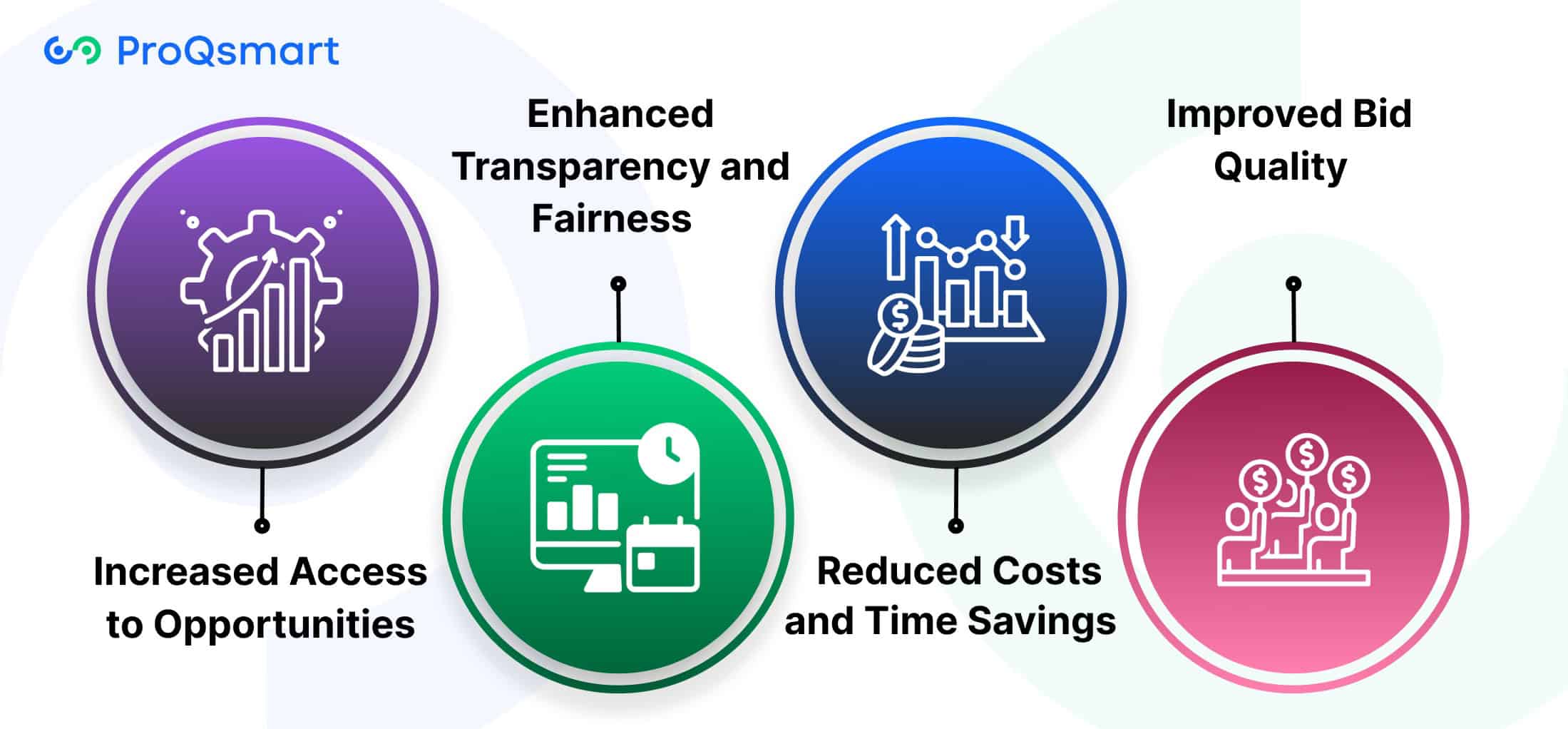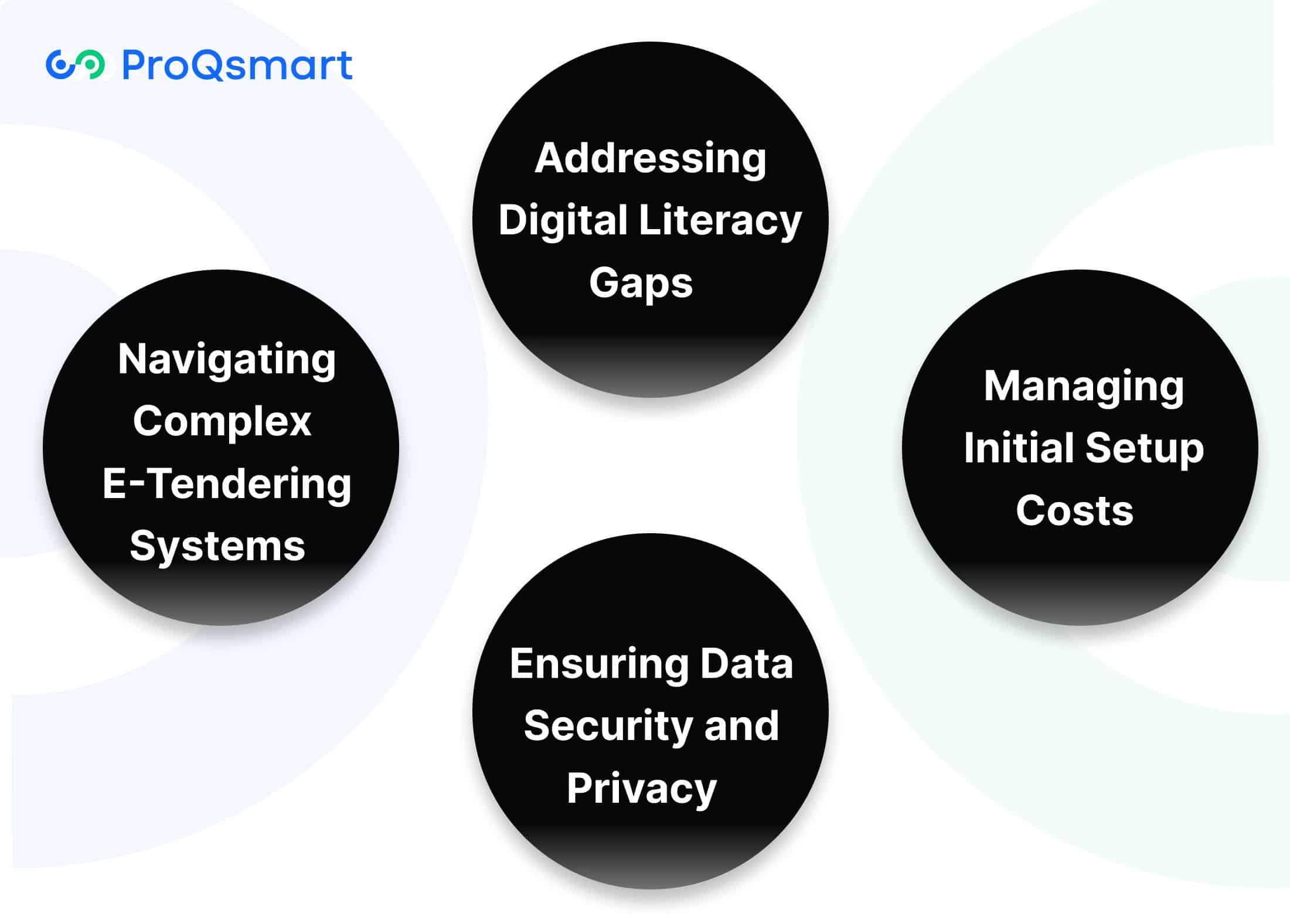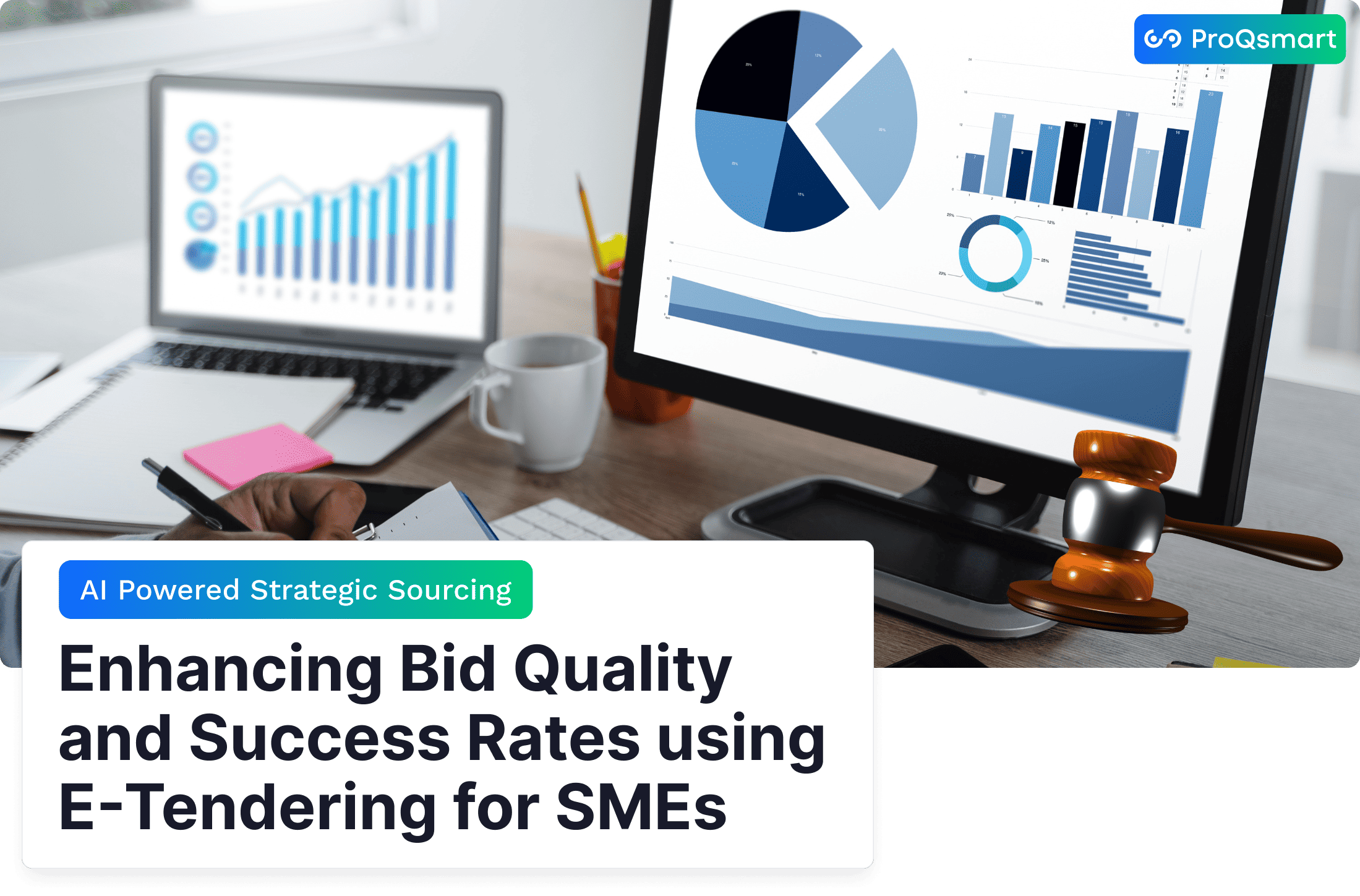E-tendering is a digital process that streamlines the management of procurement tenders, enabling organizations to improve efficiency, transparency, and cost-effectiveness in sourcing. It replaces traditional paper-based systems by leveraging online platforms for creating, submitting, and evaluating tender documents.
With features like automated workflows, real-time communication, and secure document handling, e-tendering reduces the risk of errors and ensures compliance with procurement regulations. By centralizing operations, it simplifies vendor management, enhances bid evaluations, and fosters fair competition among suppliers.
For procurement professionals, adopting e-tendering not only saves time but provides actionable insights through data analytics. In the following sections, we will explore the benefits of e-tendering and how it supports sustainable procurement practices in today’s competitive market.
Why E-Tendering Matters for SMEs
E-tendering is helping to revolutionize procurement and leveling the playing field so that SMEs can flourish in their competitive markets. Taking the tender process digital represents tremendous opportunity for small and medium-sized enterprises (SMEs).
These platforms encourage transparent competition, improve efficiency and innovation, and allow all businesses—especially SMEs—to thrive. This change would be truly transformative. For one, SMEs represent nearly 90% of businesses worldwide and create 50% of all jobs.
Leveling the Playing Field
E-tendering levels the playing field for SMEs by eliminating common obstacles like confusing paperwork, geographic constraints, and expensive bidding processes. This electronic tendering system ensures transparency in the tendering process, allowing all potential vendors insight into submitted bids and their due dates.
Streamlining Procurement Processes
Not only does e-tendering make the procurement process less cumbersome, it decreases submission time by as much as 50%, while alleviating administrative costs. Electronic submissions remove costs associated with printing and postage, saving implementers thousands of dollars per project.
Cutting-edge, real-time data analytics provide unprecedented insights into the bidding process, assisting SMEs in their efforts to fine-tune bids and maximize success rates. These optimized workflows result in shorter, cheaper procurement cycles—a game-changer for small businesses.
How Can E-Tendering Benefit SMEs?

E-tendering offers small and medium enterprises (SMEs) a streamlined, technology-driven approach to the procurement process, providing tools to compete effectively in a dynamic market. Through smart use of e-tendering platforms, SMEs gain new opportunities, operate more efficiently, and enhance their position in the competitive bidding auctions.
1. Increased Access to Opportunities
Centralized e-tendering platforms help to connect SMEs to lucrative opportunities. These go from public procurement contracts, private corporations tenders, and closed buyer auctions.
These platforms simplify the process of searching for tenders. Companies can search and sort projects by industry, location, or budget to find the ones that fit their needs best.
For instance, a SME providing construction materials can easily see all local government projects in need of their materials. Digital platforms serve as a bridge, helping suppliers and buyers establish meaningful connections while reducing the challenges of navigating traditional networks.
2. Enhanced Transparency and Fairness
E-tendering ensures equal evaluation of bids, supported by audit trails that promote accountability. By automating bid assessments, these platforms reduce favoritism, offering all participants a fair shot.
For example, ProQsmart enhances transparency by providing a secure and auditable process, ensuring compliance while fostering trust between stakeholders.
3. Reduced Costs and Time Savings
Digital procurement means less administrative overhead, cutting the paperwork and creating more efficient workflows through automation. SMEs save time through features like instant notifications and document uploads.
4. Improved Bid Quality
E-tendering enhances the quality of submissions by incorporating methods for constructive criticism and establishing clear guidelines. ProQsmart promotes robust documentation and supplier performance tracking, enabling SMEs to refine their bids through the digital tender process.
Overcoming E-Tendering Challenges for SMEs

Beyond compliance and engagement, e-tendering provides SMEs with innovative solutions to improve efficiency, save time and money, and increase competitiveness. Embracing this digital future is absolutely essential, but it’s not without its challenges. SMEs have to overcome gaps in skills, infrastructure, and resources as well.
By identifying these e-tendering challenges and putting plans in place to overcome them, SMEs can make the most of what e-tendering has to offer.
Addressing Digital Literacy Gaps
Most SMEs with no access or bandwidth have low digital literacy, posing yet another barrier to e-tendering adoption. Comprehensive training programs specifically designed for procurement professionals are needed to close these gaps, making sure that procurement teams can use e-tendering platforms to their full potential.
Systems that are intuitive and easy to use, such as ProQsmart, make a powerful impact in smoothing this transition. ProQsmart’s intuitive interface simplifies bidding, document management, and supplier collaboration, making it accessible even to less tech-savvy users.
In addition, targeted educational resources, like informative webinars and easy-to-follow guides, can equip SMEs with the information they need to navigate e-tendering processes with confidence.
Managing Initial Setup Costs
Moving onto e-tendering can be challenging without sizeable up-front investment. SMEs can halve their costs by finding grants or rebates offered by industry groups.
ProQsmart’s budget-driven procurement tools ensure every dollar spent matches what’s happening in real-time, optimizing expenditures for the best possible cost effectiveness. In the long run, SMEs save on operational costs, productive time, and more, proving the long-term value of e-tendering and e-sourcing systems.
Ensuring Data Security and Privacy
Robust security measures should be established and enforced to protect sensitive procurement data. ProQsmart delivers peace of mind for data compliance with auditable sourcing records and automated workflow, keeping all pertinent data and communication on file.
Regular supplier performance monitoring is an example of best practices that not only keeps stored information secure, but fosters trust across the ecosystem.
Navigating Complex E-Tendering Systems
Some platforms are so complicated that they actually intimidate SMEs. ProQsmart addresses this by offering on-the-go, real-time assistance.
It presents powerful integrations that make things easier, like when managing subcontractors or making changes to bill of quantities. Practical resources and collaboration tools foster smoother operations, ensuring SMEs can focus on their strategic goals.
Strategies to Enhance Bid Quality using E-Tendering System

With the introduction of e-tendering systems, the digital procurement process has experienced a revolution that has allowed for quicker, clearer, and overall better bid quality. To really maximize value on these procurement platforms, focus on strategic, laser-focused tactics. Taking these steps can significantly improve bid quality results, enhance supplier relationships, and increase operational efficiency.
Identify Key Features of E-Tendering Systems
The best e-tendering platform provides you with tools that make the bidding process easier. User-friendly interfaces make navigation easy. Real-time updates keep suppliers informed on submission deadlines and project changes.
For instance, digital forms guide suppliers in providing accurate information, reducing errors in documentation. Aggregated data collection provides instant access to the most recent versions of bids, enabling suppliers to ensure they are more consistent from bid to bid.
ProQsmart further strengthens these capabilities by automating data extraction and bidder pre-qualification, ensuring only qualified suppliers are invited to bid.
Create Best Practices for Bid Preparation
Developing high-quality bids doesn’t happen overnight. It begins with intensive research to find out exactly what the buyer needs, and what their real priorities are. Log the proposals in a way that would meet audit measures and show adherence to submission instructions.
Employing digital platforms such as ProQsmart encourages transparency, allowing suppliers to learn more about the organization that they’re working with, building trust, and establishing long-lasting collaborative relationships.
Utilize Analytics Tools to Refine Strategies
Platforms using machine learning, like ProQsmart, offer powerful analytics capabilities that analyze previous bids to score and predict future bid performance. By identifying what went wrong with these key insights, suppliers can focus their efforts on strengthening weak spots and improving quality for the next opportunity.
AI and automation further help reduce the burden of repetitive, time-consuming tasks, making processes more efficient and decisions more accurate.
Foster Collaboration Among Team Members
The centralized communication features of e-tendering systems enable all teams involved to share information in real-time. This digital procurement process fosters faster, more collaborative workflows, ultimately saving time and money while enhancing supplier participation to meet current procurement needs and trends.
E-Tendering Best Practices for SMEs
Implementing e-tendering best practices can significantly enhance the procurement process for small and medium-sized enterprises (SMEs). This results in quicker submissions, greater transparency, and increased access to opportunities in the digital procurement process. By leveraging these best practices, SMEs can improve their time and cost efficiencies while boosting competitiveness when bidding for projects.
Early Engagement with Stakeholders
Beginning the competitive bidding process with the early involvement of key stakeholders helps to clarify each party’s goals and priorities. Clear communication during this stage helps identify specific requirements, reducing misunderstandings later.
Developing relationships with prospective clients via these preliminary conversations builds trust and frames your business as a proactive partner. For example, attending webinars or other virtual information sessions organized by municipal officials can help demystify convoluted procurement processes and bidding requirements.
Effective Use of Collaboration Tools
Collaborating on a single, purpose-built digital platform truly brings out the best in procurement teamwork and results in higher quality submission. Tools that provide integrated real-time communication and document sharing enable bid teams to work together effortlessly, ensuring no key detail slips through.
Structured platforms have allowed SMEs to deliver more competitive offers in less time, in some cases cutting submission time by as much as 50%. This group effort allows for the most detailed and refined submissions.
Thorough Review of Tender Documents
Therefore, a thorough analysis of tender documents can be the key. Understanding the important requirements and evaluation criteria helps you cover all bases while focusing on the most important features.
Simple checklists can do wonders for tracking progress and making sure no last-minute detail slips through the cracks. Take, for instance, SMEs producing on behalf of government contracts whose materials must be inspected through a predictable document-review process to maintain compliance.
Timely Submission of Bids
Deadlines are something that you cannot play with. Late submissions are often the death knell for bids, highlighting the importance of foresight and planning.
Using e-tendering platforms that reduce submission time by 50% allows SMEs to meet deadlines.
Continuous Improvement and Learning
Continuing to seek feedback from evaluators and integrating those lessons into future bids is essential for improving your approach in the electronic tendering process. Providing access to training sessions and performance tracking systems fosters capacity building.
Conclusion
E-tendering provides a transformative opportunity for SMEs to compete on equal terms, leveraging technology to enhance their bidding strategies and expand their market reach. By focusing on targeted strategies and utilizing the tools available, SMEs can sharpen their bids and rise above the competition. While integrating e-tendering systems may present initial challenges, the benefits of increased efficiency, transparency, and equitable contracting practices make the effort worthwhile. E-tendering not only helps SMEs tap into wider markets but also offers a cost-effective and productive way to manage procurement processes.
Ready to unlock the full potential of e-tendering for your SME? Book a demo with ProQsmart today to discover how ProQsmart’s innovative solutions can streamline procurement processes, enhance bidding strategies, and drive business growth.




